For the Best Food in Bangkok, Hit the Streets
30 Jul 2014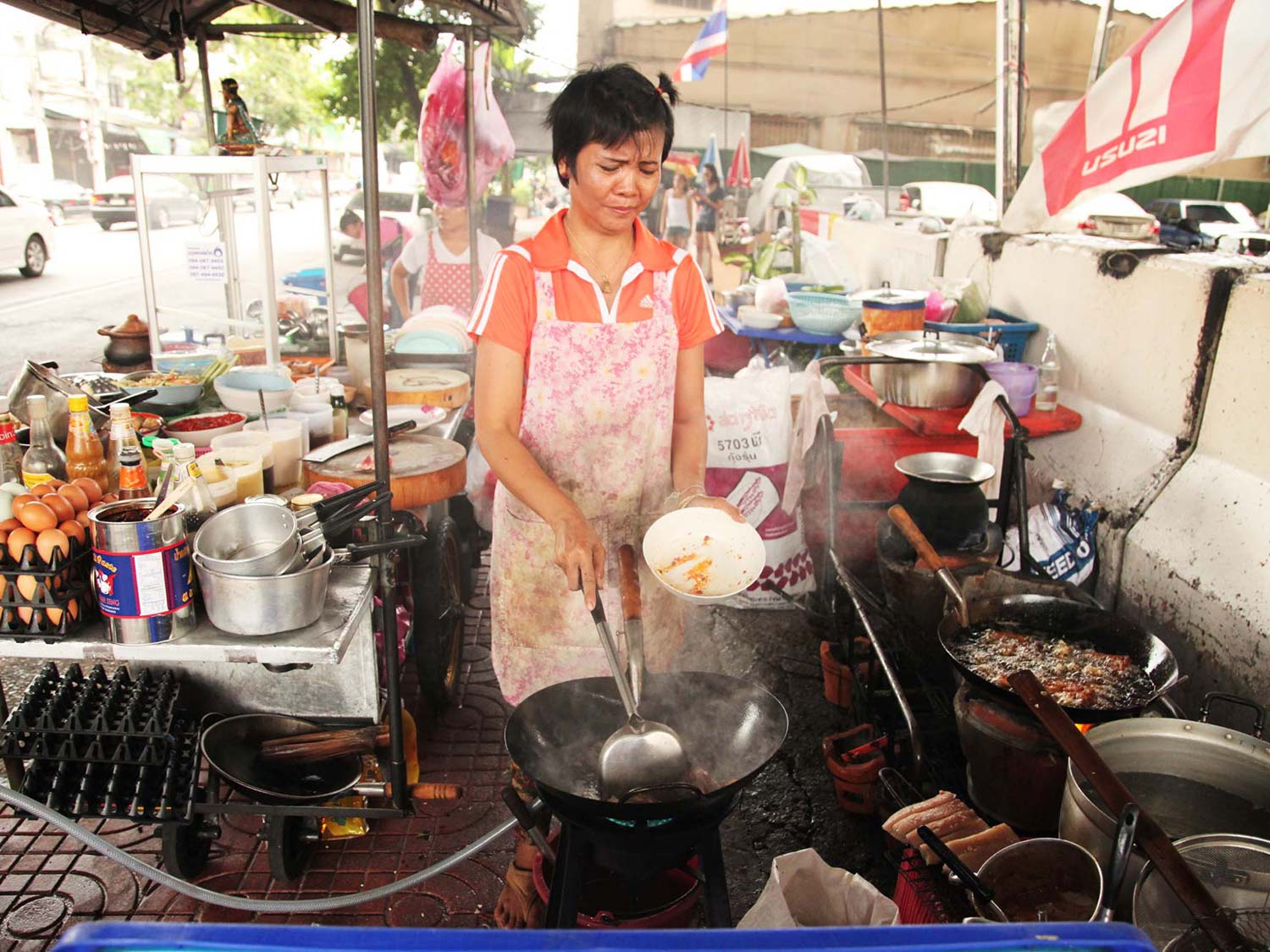
You can wander the street of Bangkok for weeks, pointing at every single thing that looks tasty, handing over a coupe dozen baht, and eating until you burst and never eat the same thing twice. And you'd have difficulty spending more than around $10 a day doing it. And, in fact, that's pretty much what Adri and I did for the few days we were there.
Everywhere you go, from the fancy shopping malls downtown, to the grungy streets of Chinatown, to the vast semi-outdoor markets—even in the hyper-touristy areas around the gorgeous wats and palaces in the old city—you'll find hawkers offering you fresh-cooked meals which you consume while perched on little plastic seats around a makeshift picnic table.
Here's just a taste of what you'll find:
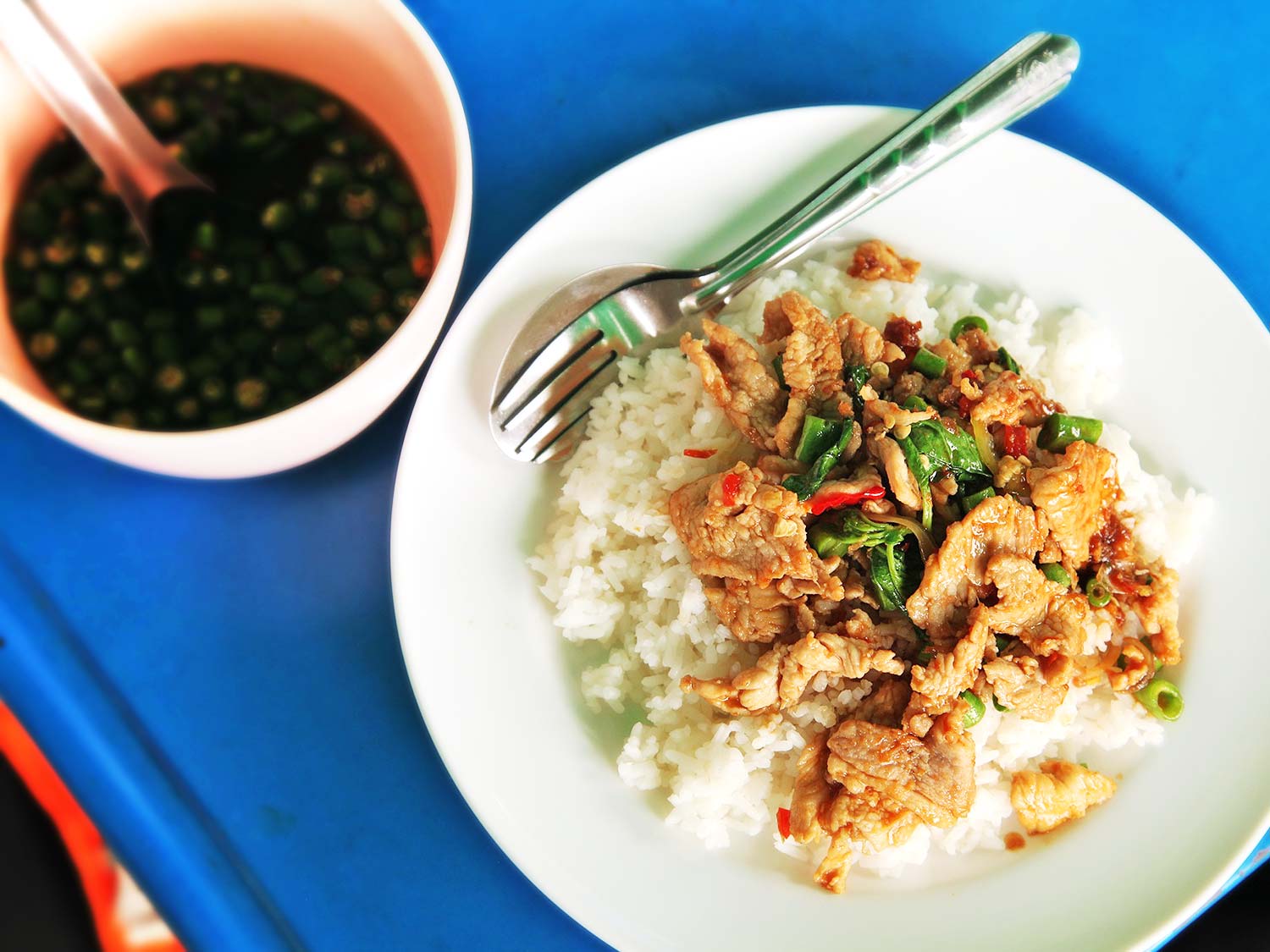
Stir-fried pork or chicken with holy basil and chilies is one of the most common streetside dishes. If you order it, don't forget to ask for a fried egg on top. I forgot and paid for it with an only slightly less delicious meal.
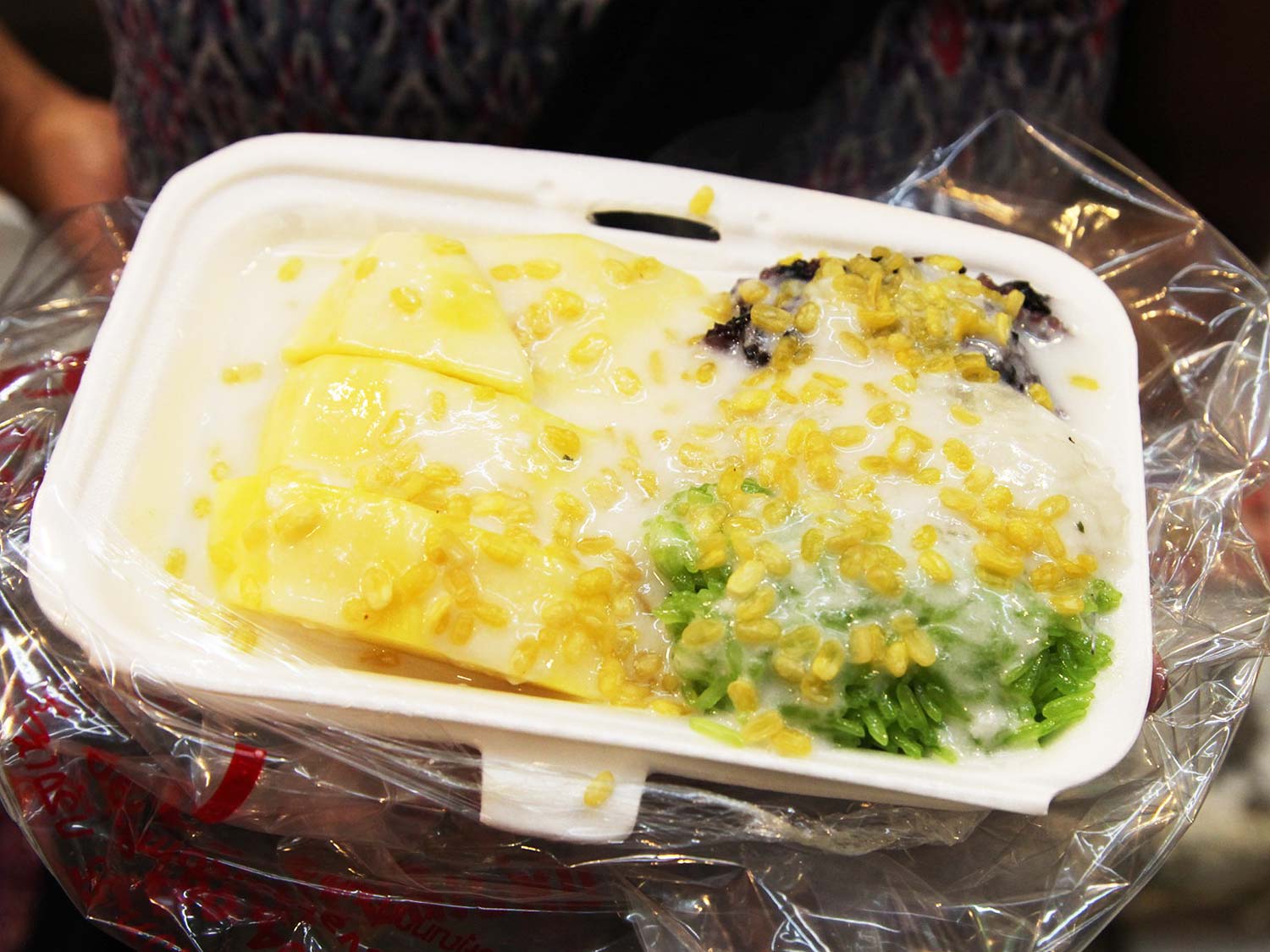
We were warned by the lady selling the mangoes that they were out of the best one, so we'd have to settle for something not as sweet. It was still the best mango sticky rice I've ever tasted.
You know mango sticky rice from Thai restaurants in the states—sliced mango served on top of sticky rice with sweet-and-salty coconut cream and puffed rice crisps—but you haventt had it until you've had it with the incredibly sweet and luscious Thai honey mangoes. This version, made with three colors of sticky rice, comes from a small shop across the street from Soi 38, an alley downtown famous for its (comparatively mediocre) food stalls.
Special thanks to Bangkok native and Serious Eats' Thai food columnist Leela Punyaratabandhu for sending us here (along with the other great recommendations she gave us)
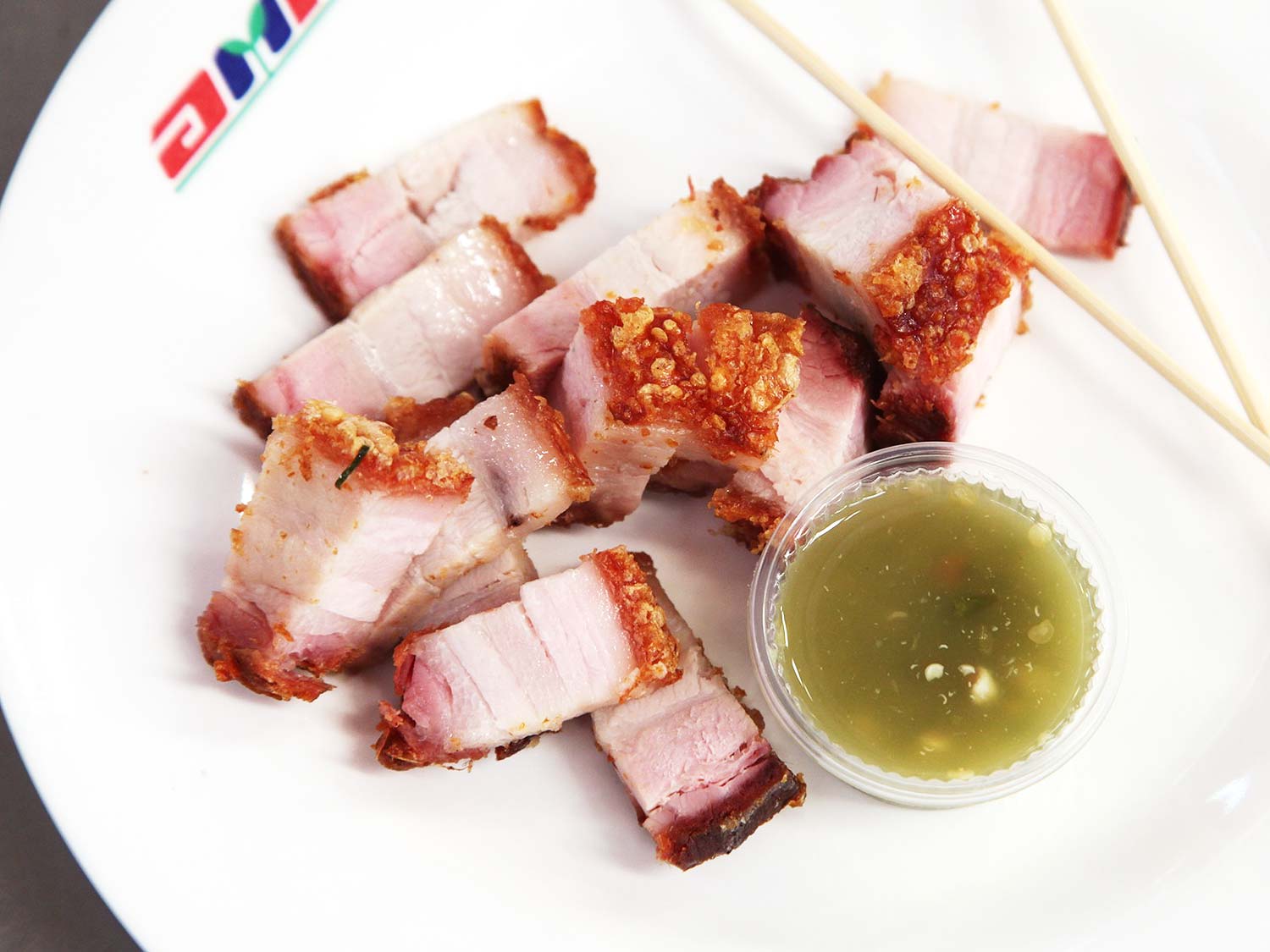
You can take your pick of roasted pork belly from the Chinese-style roasters (who also sell crisp roast duck), or fried pork belly from the Thai fried-stuff-vendors (who usually carry great fried chicken and other snacks). I prefer the latter, mostly because the Thai vendors serve their fried food with a tangy and spicy chili sauce.
This batch came from a vendor in Or Tor Kor market near the Mo Chit bus terminal.
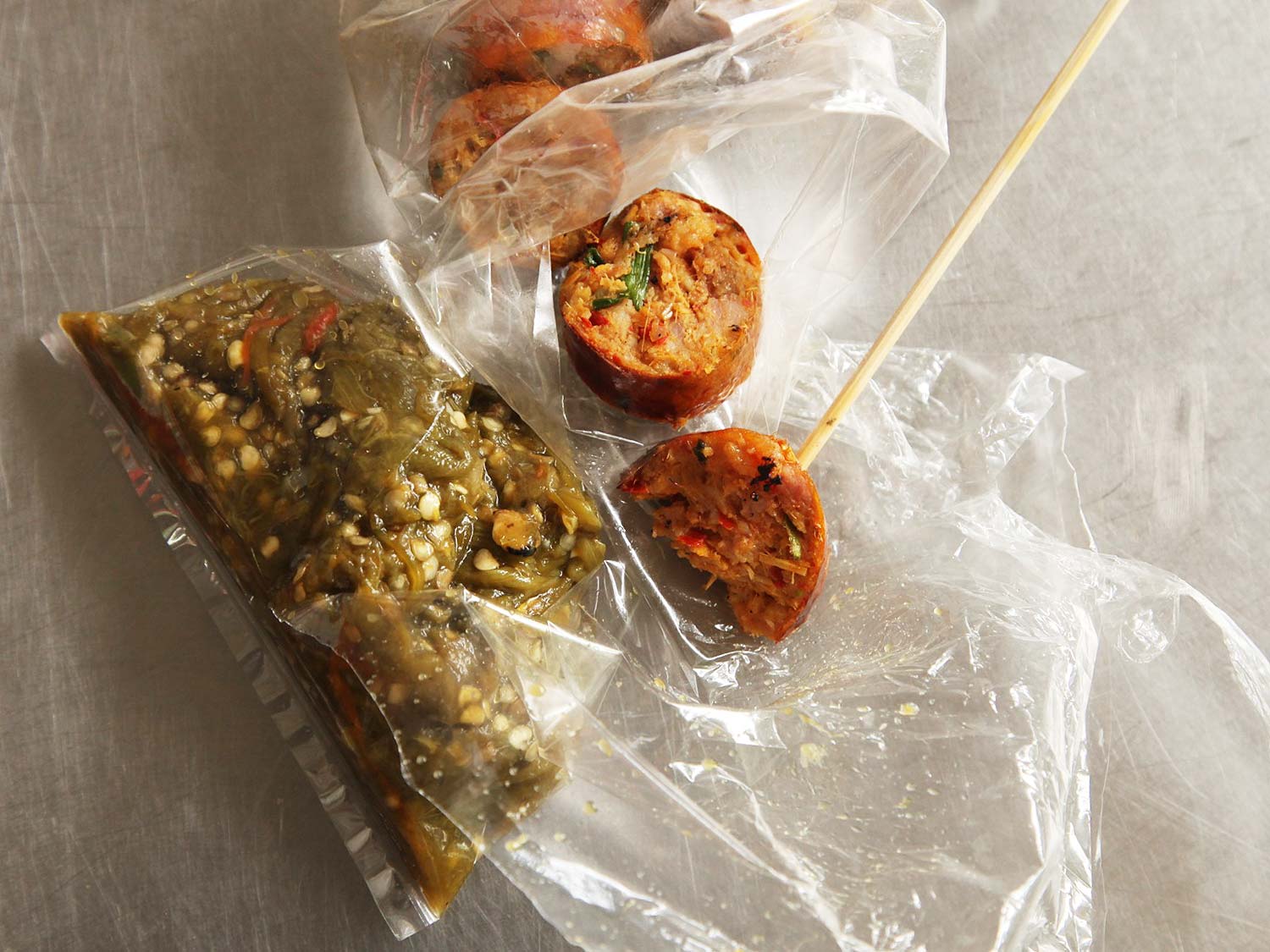
Most of the sausages you find in Bangkok are of the mildly seasoned, fermented Isan style. You can get them grilled on the street for a couple bucks. But if you poke around, you'll also find sai oua, a sausage from Northern Thailand flavored with charred kaffir lime, galangal, chilies, and other aromatics. It's generally not as juicy as its Isan neighbor, but what it lacks in moisture, it makes up in flavor.
I like to eat my sai oua with nam phrik, a spicy roasted chili paste from the north. It's also great with fried pork rinds or raw vegetables.
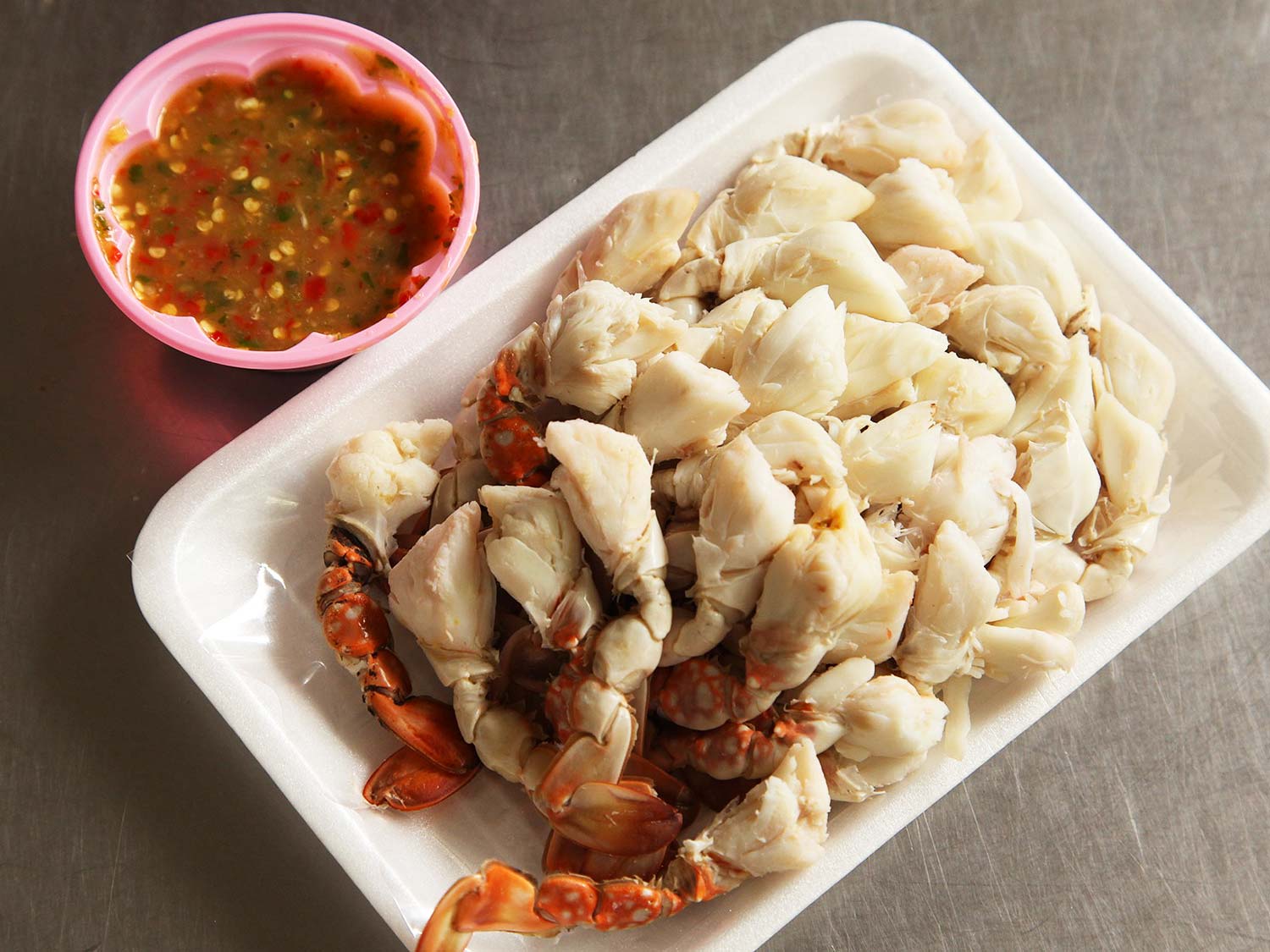
Adri is a crab fiend. The only thing that stops her from eating mountains of crab for every meal in the U.S. is the prohibitive price. That's not as much of an issue in Bangkok. We picked up this tray of steamed crab swimmerets—a full kilogram of them—for around 15 U.S. dollars. Not cheap by Thai standards, but a worthy splurge for Adri.
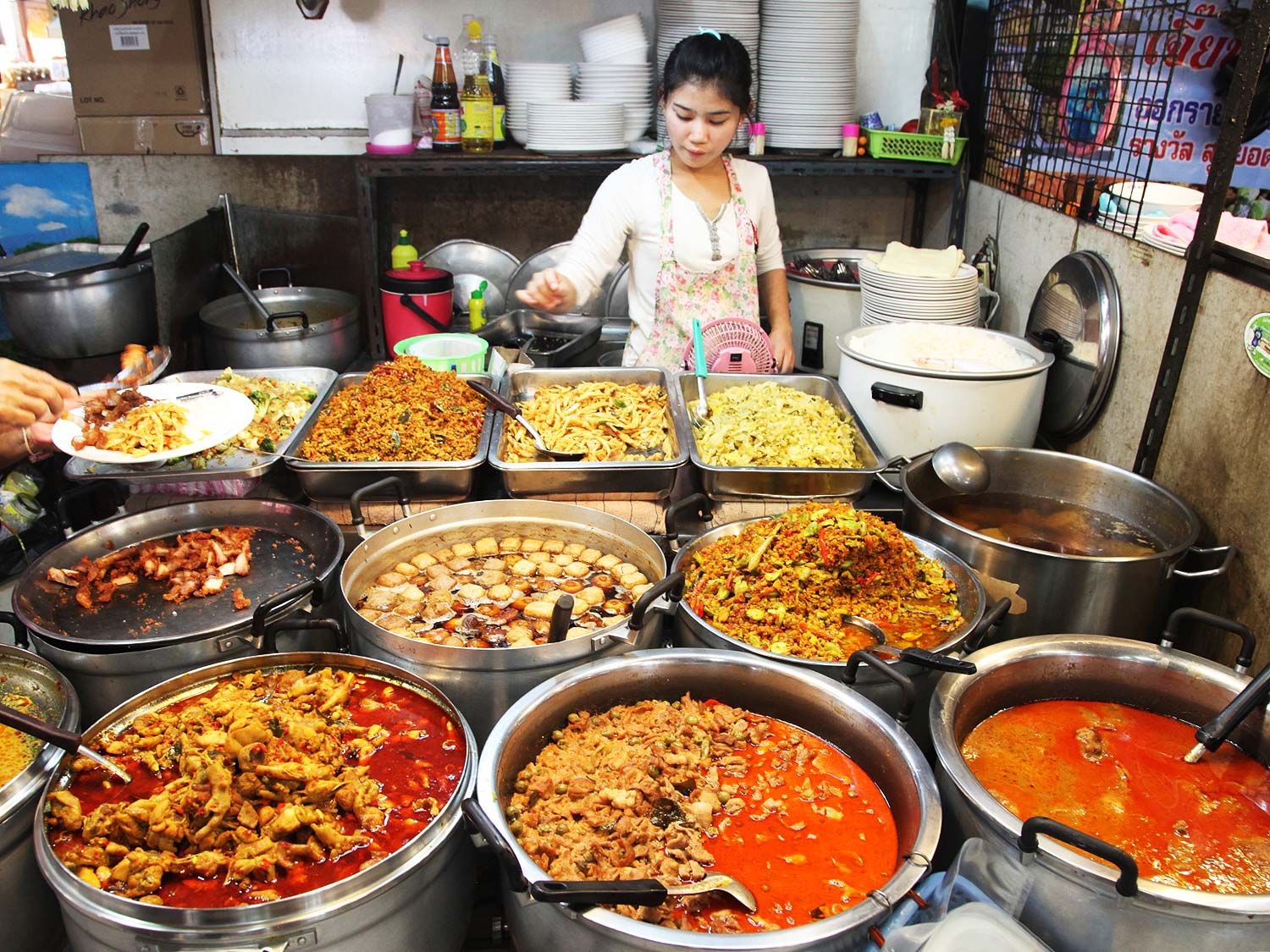
You can easily identify curry stands by the rows of pots laid out in front of them. Most will have at least a half dozen varieties of curry, as well as various simmered or stir-fried dishes held in hotel pans. Feel free to fish around inside the pots to take a look at what's inside.
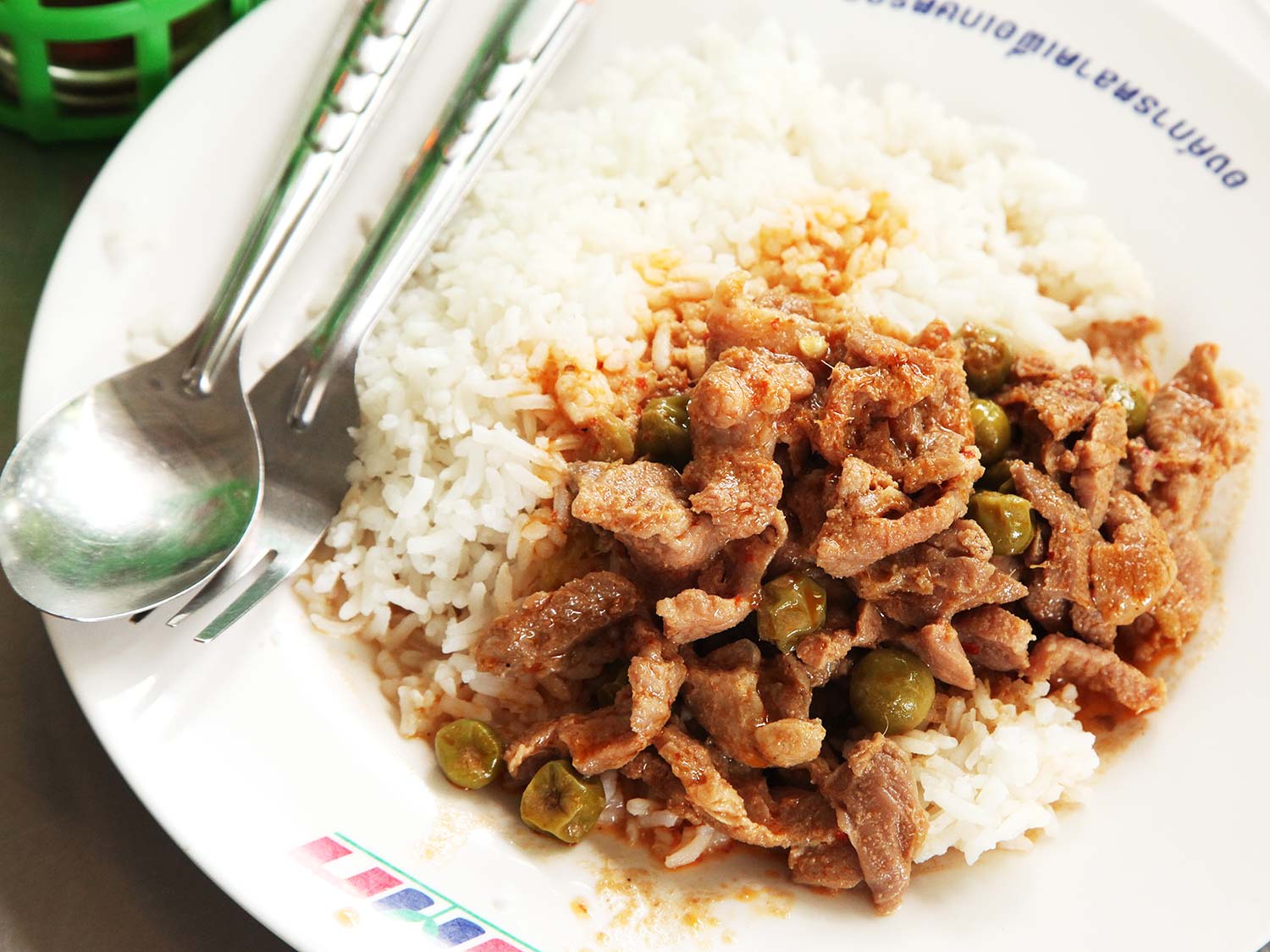
Whatever you pick, it'll come served on a plate with rice. The little green things in this red pork curry aren't peas—they're tiny bitter eggplants. Thais use chopsticks only for noodles. Everything else is eaten with a fork and spoon. To eat like a local, hold the fork in the hand you'd usually hold it in, with the spoon in your knife hand. Use the fork to pull a bit of curry and sauce into the rice, then press the whole clump up onto your spoon. Deliver the food to your mouth using the spoon. Sit and ponder how this method of eating came to be and why the prongs of the fork are never actually used for anything.
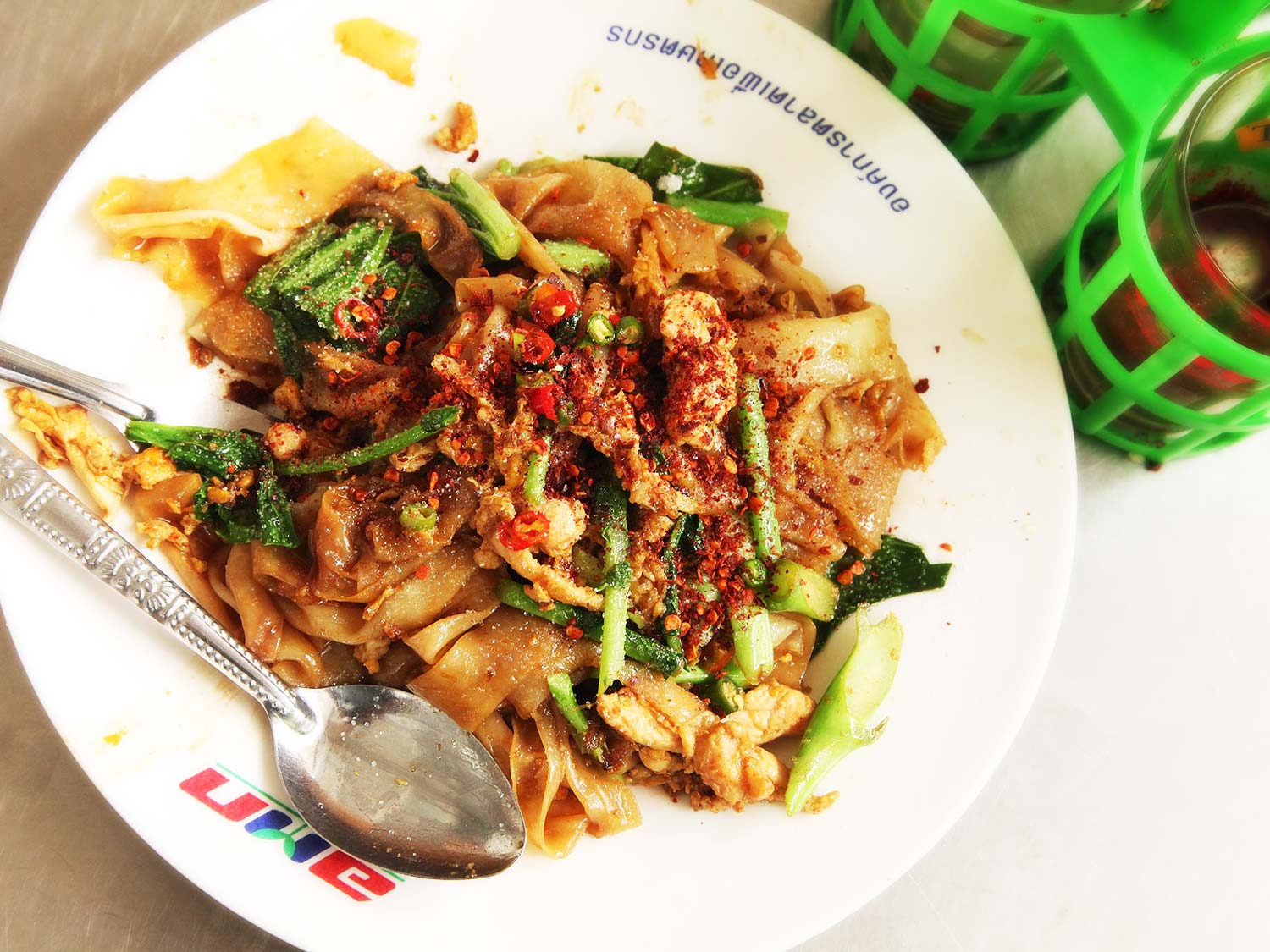
Pad si ew are readily available stateside, and the best versions I've had in the states rival what you can get in Thailand. Wide, flat rice noodles (slightly thinner than Chinese chow fun noodles, but pretty much the same) are stir-fried with scrambled egg, chopped greens (in Thailand it's usually a form of kale, in the states it might be Chinese broccoli), and sliced meat and flavored with soy and fish sauce.
In place of salt and pepper, you'll find dried ground chilies, fish sauce (often with fresh sliced Thai chilies floating in it), vinegar with mild sliced chilies, and plain white sugar on your table. Season as you see fit. In Bangkok, they tend to like things very sweet and hot. I saw a teenage girl pile four heaping spoons of sugar and a spoonful of chilies onto her noodles before stirring them up and eating them.
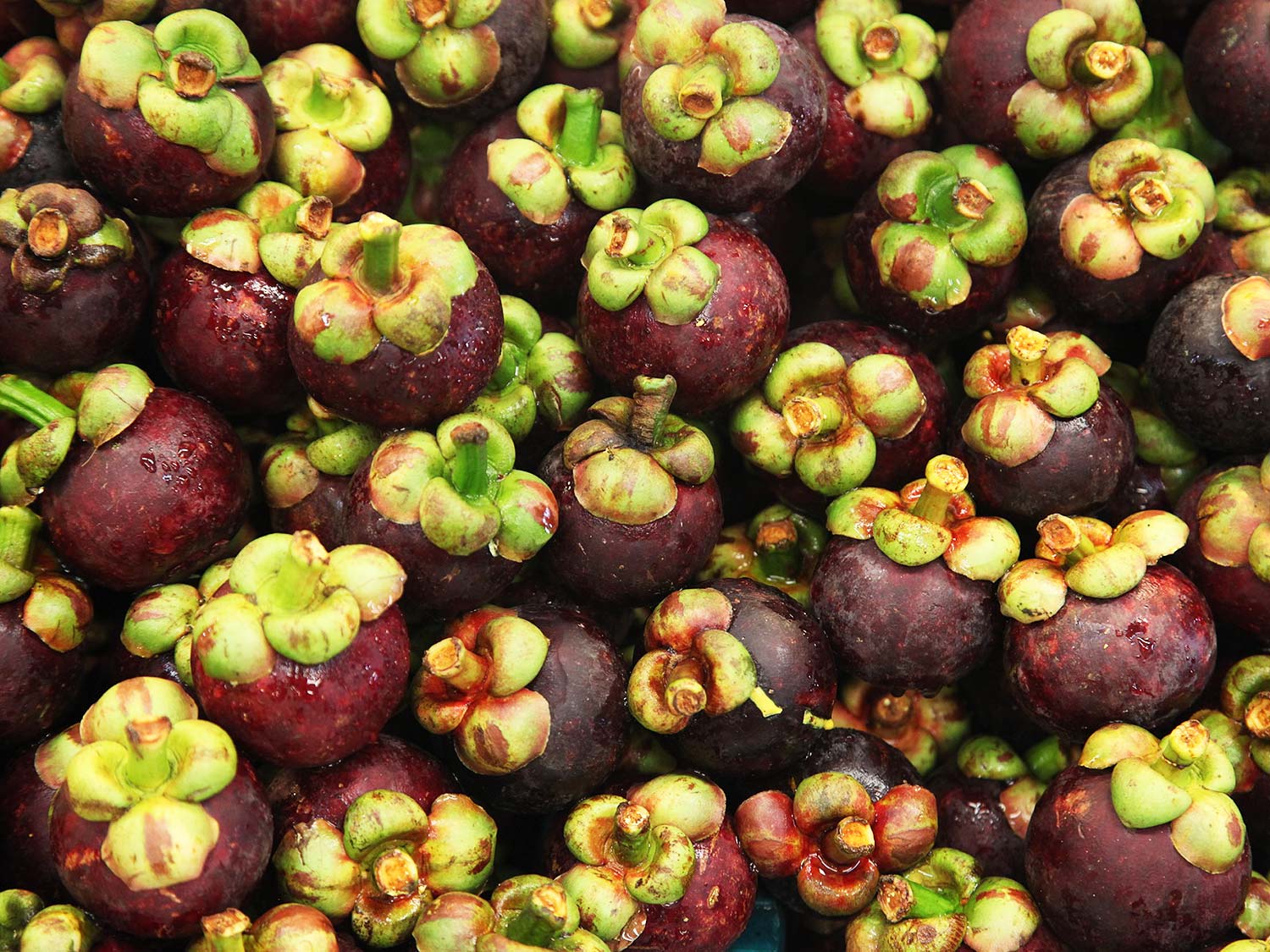
The mangosteen, known as the Queen of Fruit, happens to be my favorite fruit of all time, and lucky us, they were in season while we were in Thailand. The little aromatic fruit with the hard purple shell run around $9 a pound in Chinatown in NYC during their short, one month season. In Bangkok, the most you'll pay is about a dollar a kilo, and we found them for around half that. That's about as many mangosteens as you can eat for a quarter. Not bad.
You eat them by scoring the thick, astringent purple skin then carefully prying it open, revealing tender, segmented white flesh inside. If you do it well, the white segments will pop right out of the skin and you can eat it whole, savoring the mildly sweet, very fragrant flesh, spitting out the one or two large seeds it contains.
(You can find a whole lot more photos of Bangkok street food in this post from a previous trip)
The Best
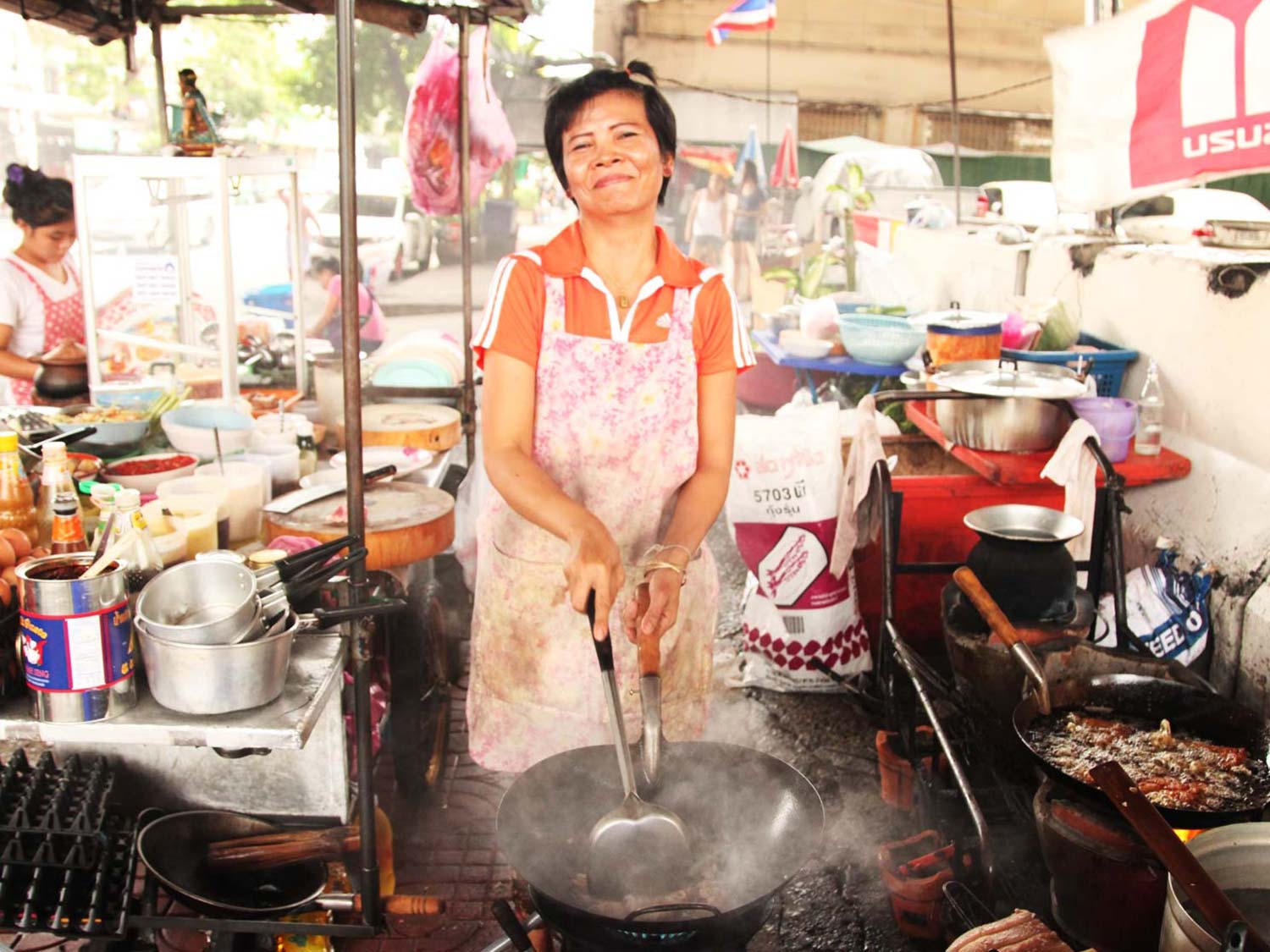
So of all this awesome food, what was the very best? Like many of the things you discover in Bangkok, we found it by accident. We walked out of our hotel near Chinatown one afternoon and started walking East without much of an end goal in mind. After winding our way through some narrow alleys, we ended up on Thanon Charu Mueang near Wat Duang Khae under the big highway underpass. I saw a lady working a hot wok near a picnic table, and spied a young couple with their faces buried in a plate covered in fried basil leaves.
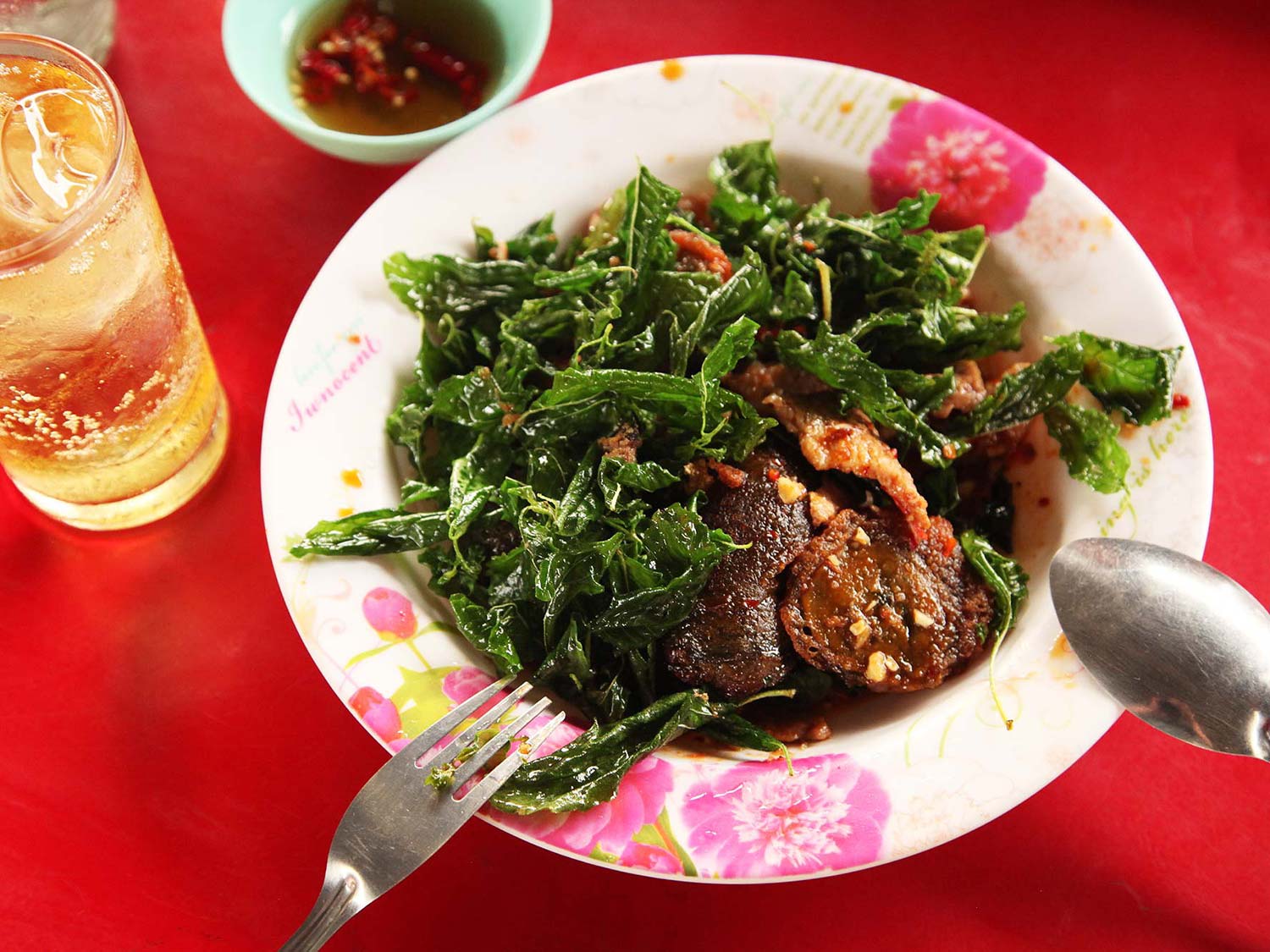
That's the dish for me, I said to myself. I then repeated it out loud for Adri's benefit. She gave one of those small dutiful sighs that I've figured out means "this is our fourth lunch of the day but I've nobody to blame but myself, I knew what I was getting into when I married him," then sat down and asked me to order her a beer. She sipped on iced Chang while I went to the lady and after much pointing and gesturing, managed to communicate "I'd like the same delicious-looking thing as that couple sitting over there."
She nooded, smiled, and got to work.
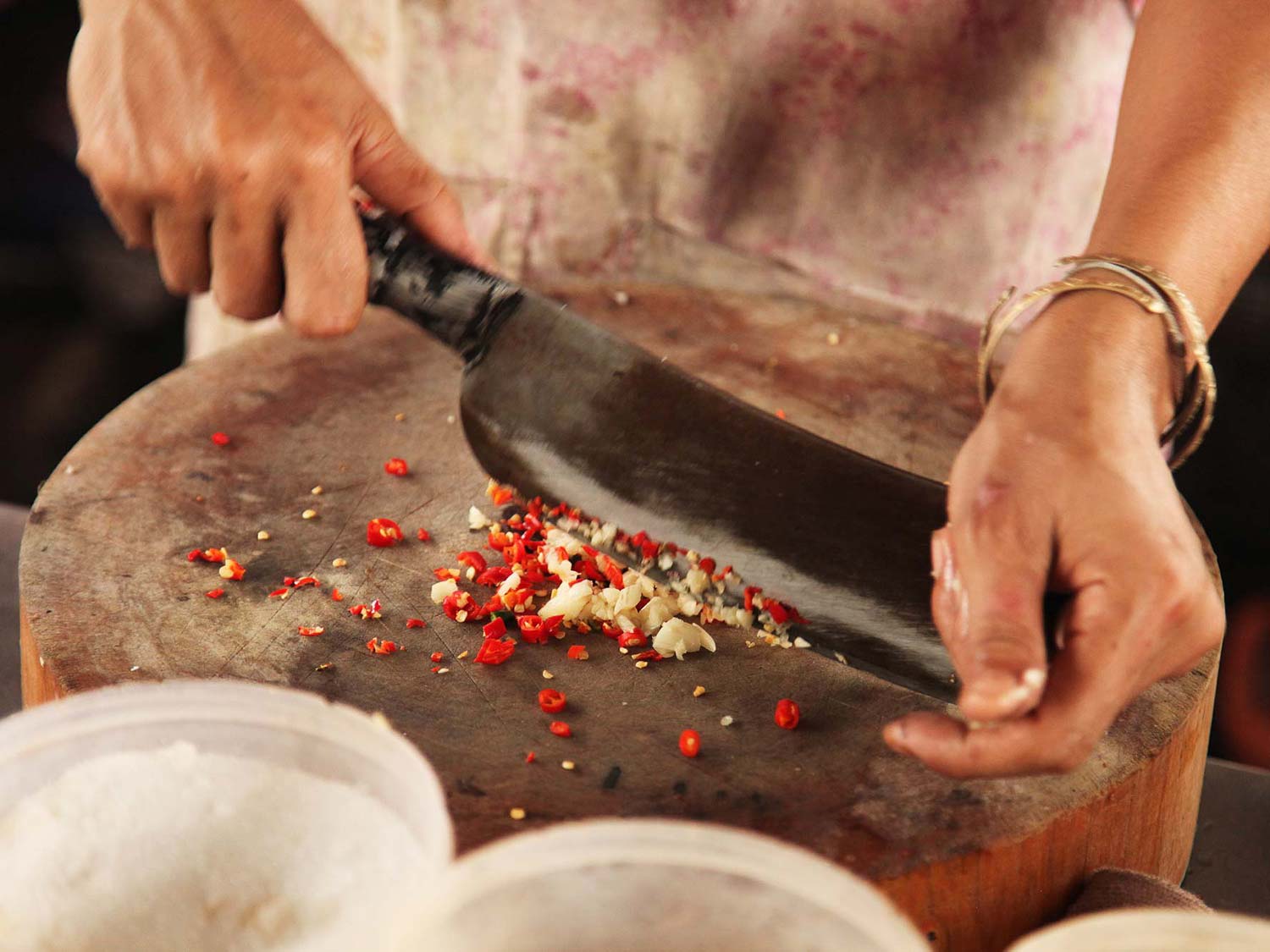
She started by chopping garlic and hot Thai bird chilies together with a large cleaver before dumping them into a small bowl.
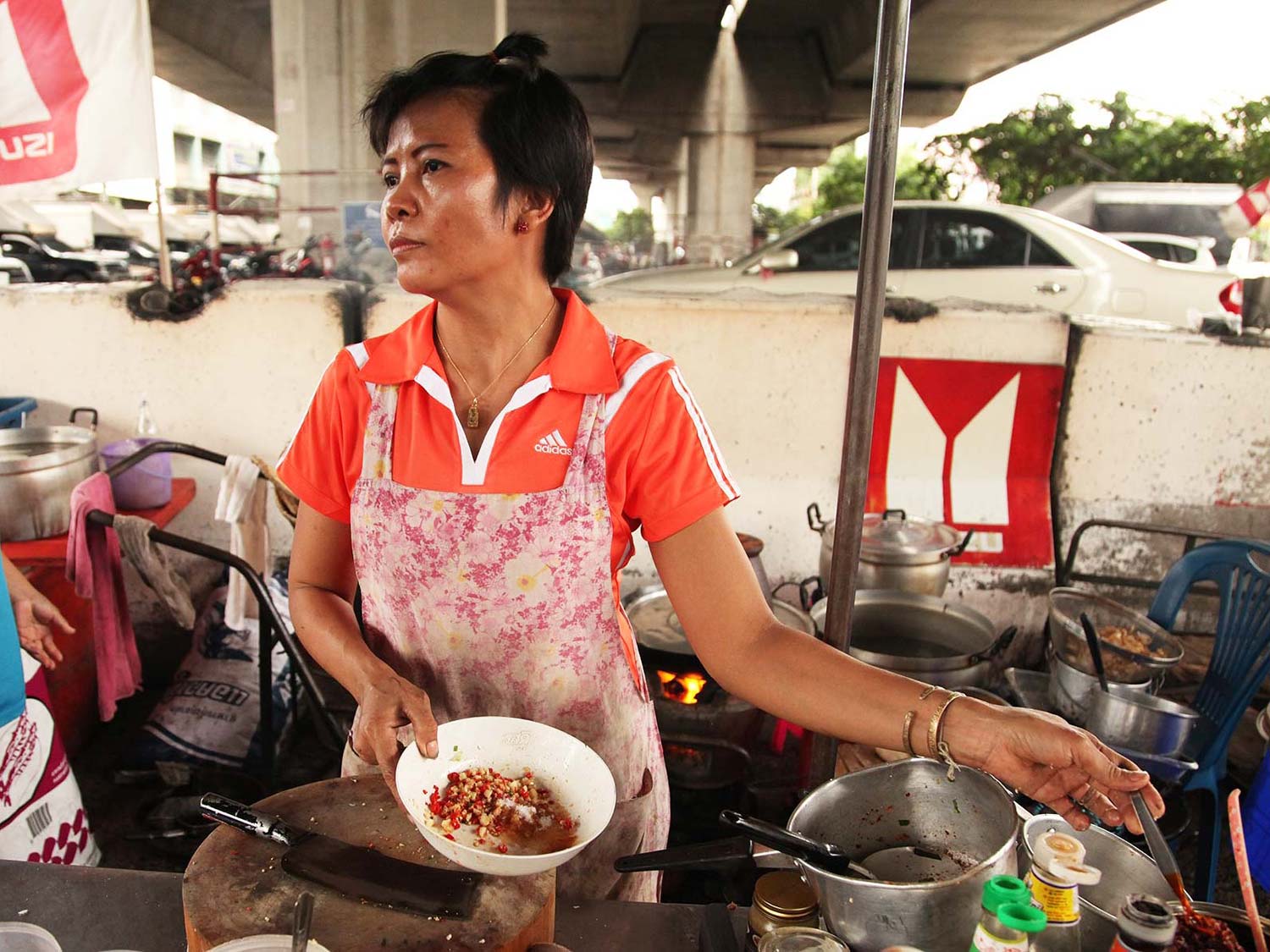
Next she added a couple spoonfuls of sugar, a big glug of fish sauce, and a small dash of thin Thai oyster sauce and set the bowl aside.
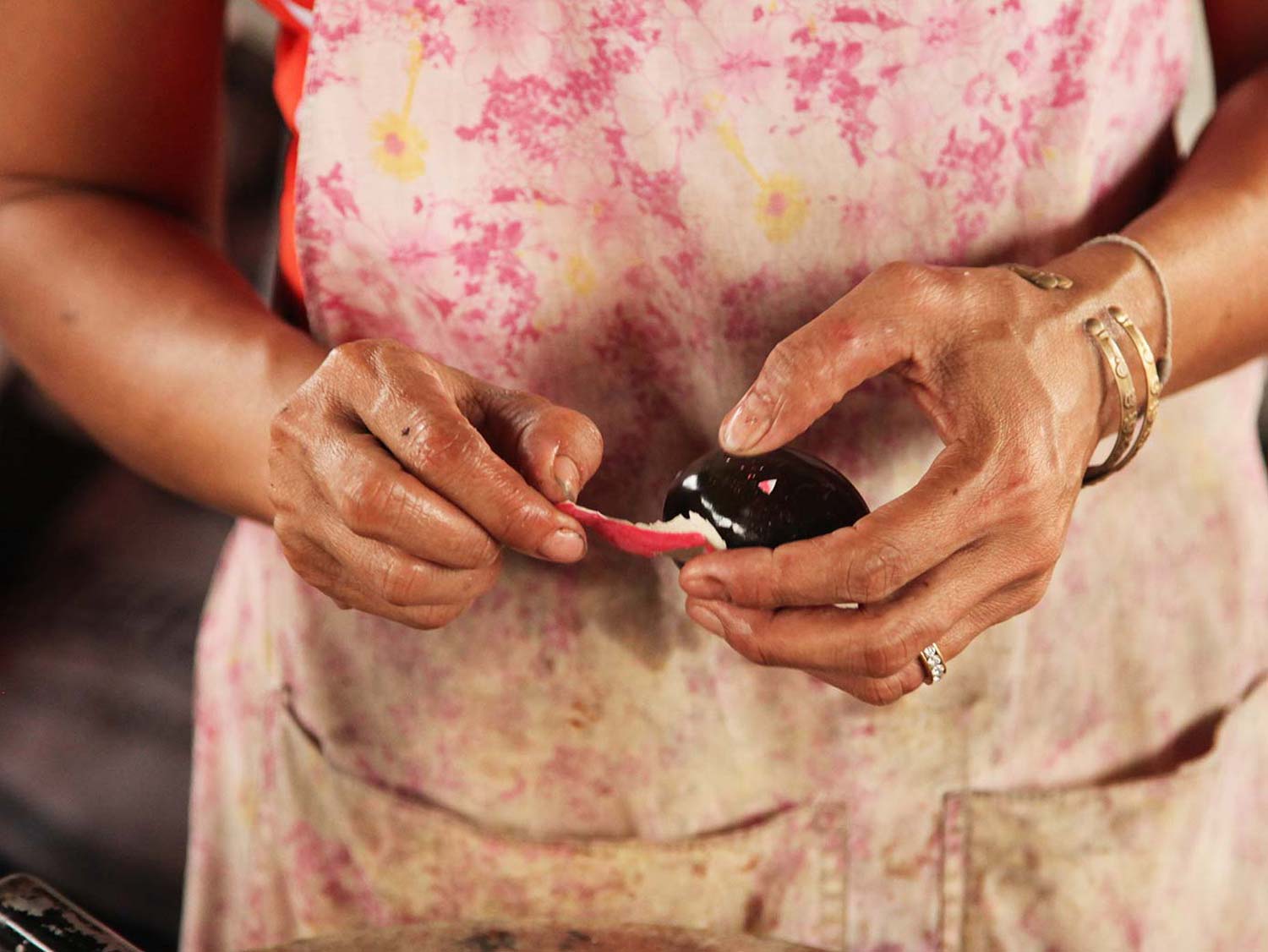
Next up, thousand year eggs. This Chinese preparation involves curing raw duck eggs in salt and tea leaf ashes for several weeks until the whites develop a dark brown color and firm texture, with a creamy green yolk.
They're actually much milder in flavor than you'd expect, tasting mostly like boiled eggs, but with a slightly camphorous and sweet aroma.
After peeling them, she did something that I was not expecting at all:

Yup, the deep fryer. The halved the eggs and dropped them in, pulling them out after their exteriors turned bubbly and crisp. I've honestly never thought to deep fry an already-hard egg, but given the results with thousand year eggs here, I'm gonna have to give it a go with regular boiled eggs when I get home.
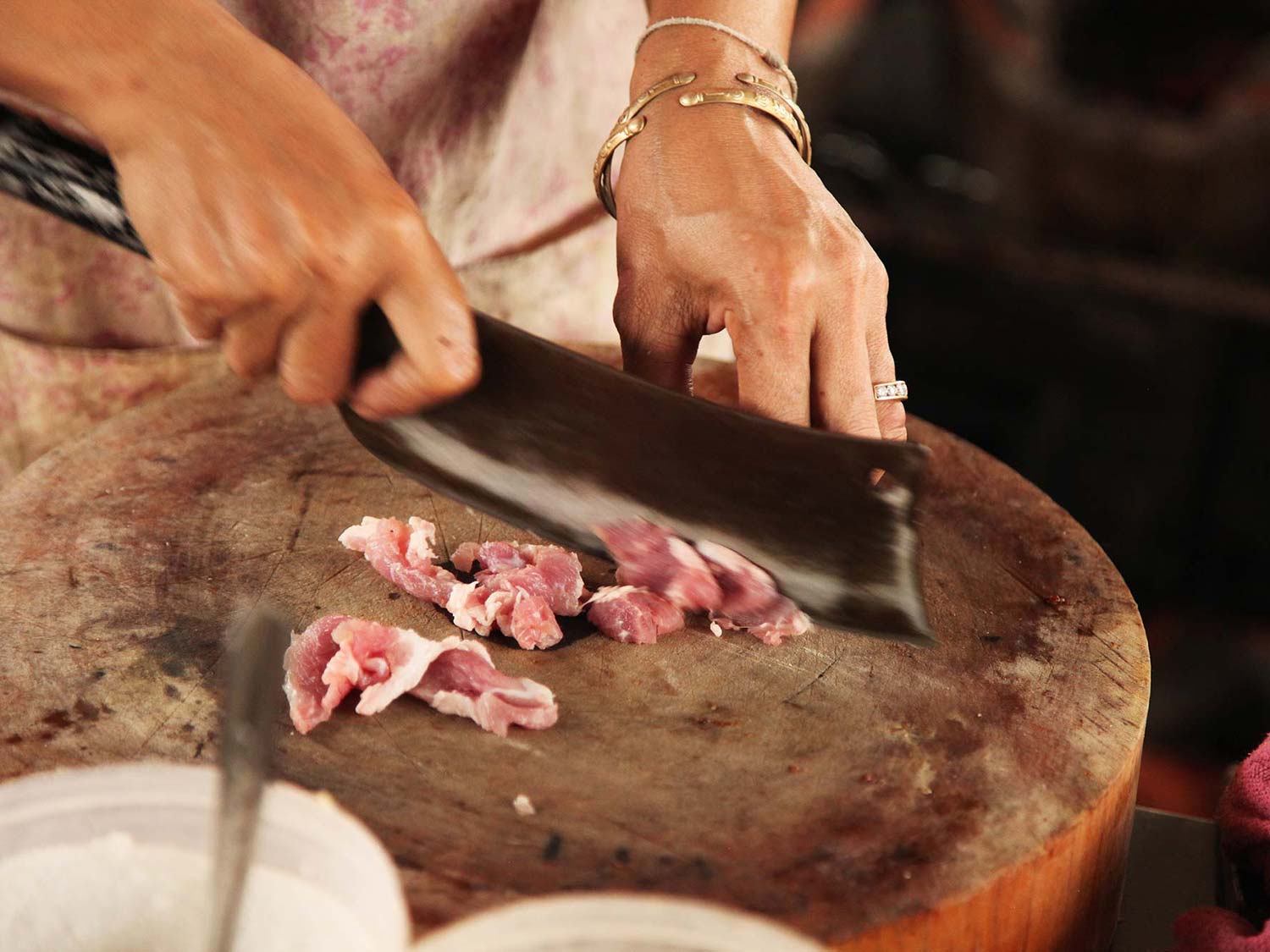
With the eggs cooked, she moved on to a hunk of pork, thinly slicing it. Pretty much every food stand you go to will slice proteins to order here.
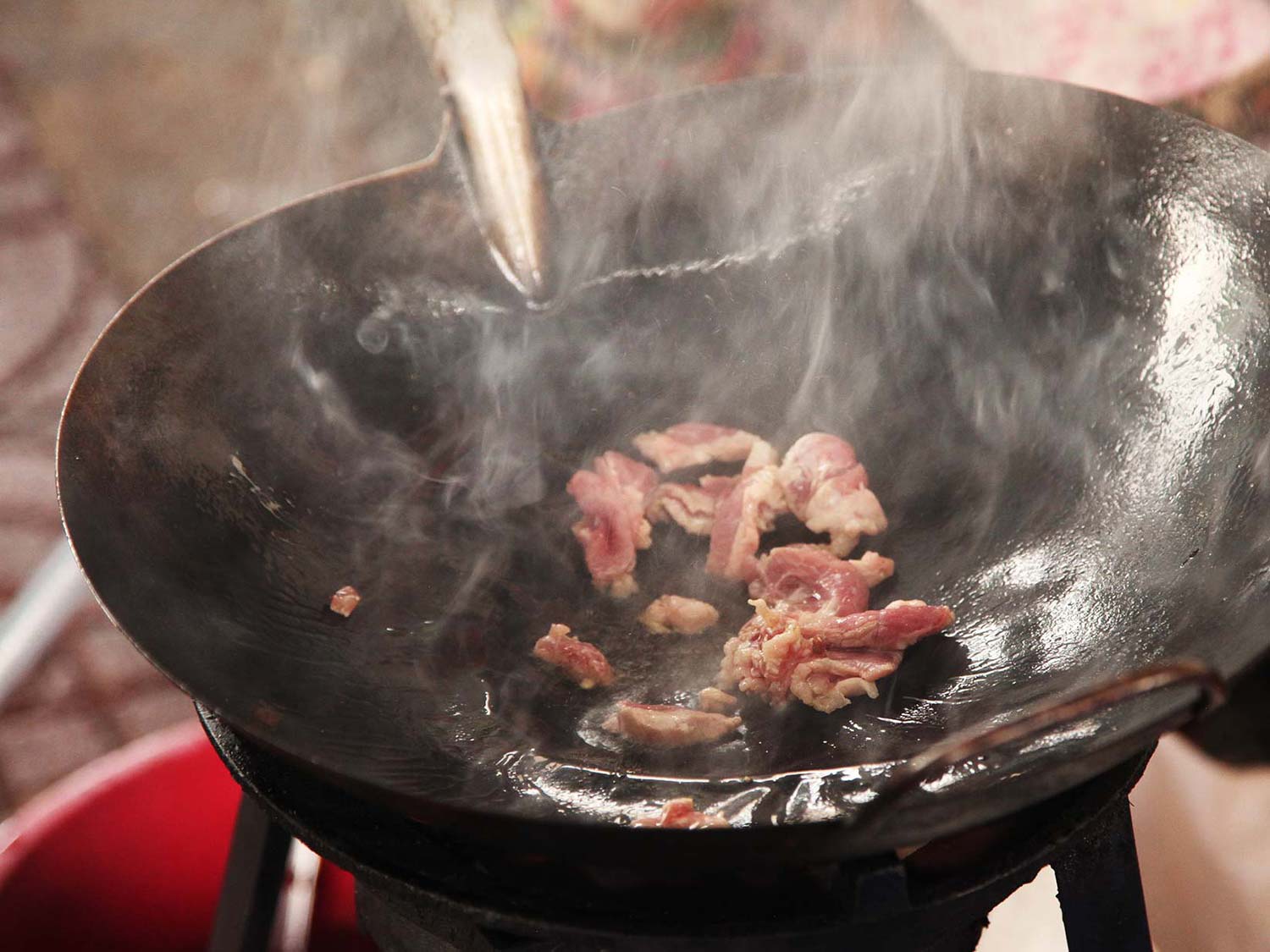
She heats up some oil in a blazing hot wok, then adds the pork slices, stir-frying them just for a moment before adding the eggs along with the garlic, chili, and sauce mixture.
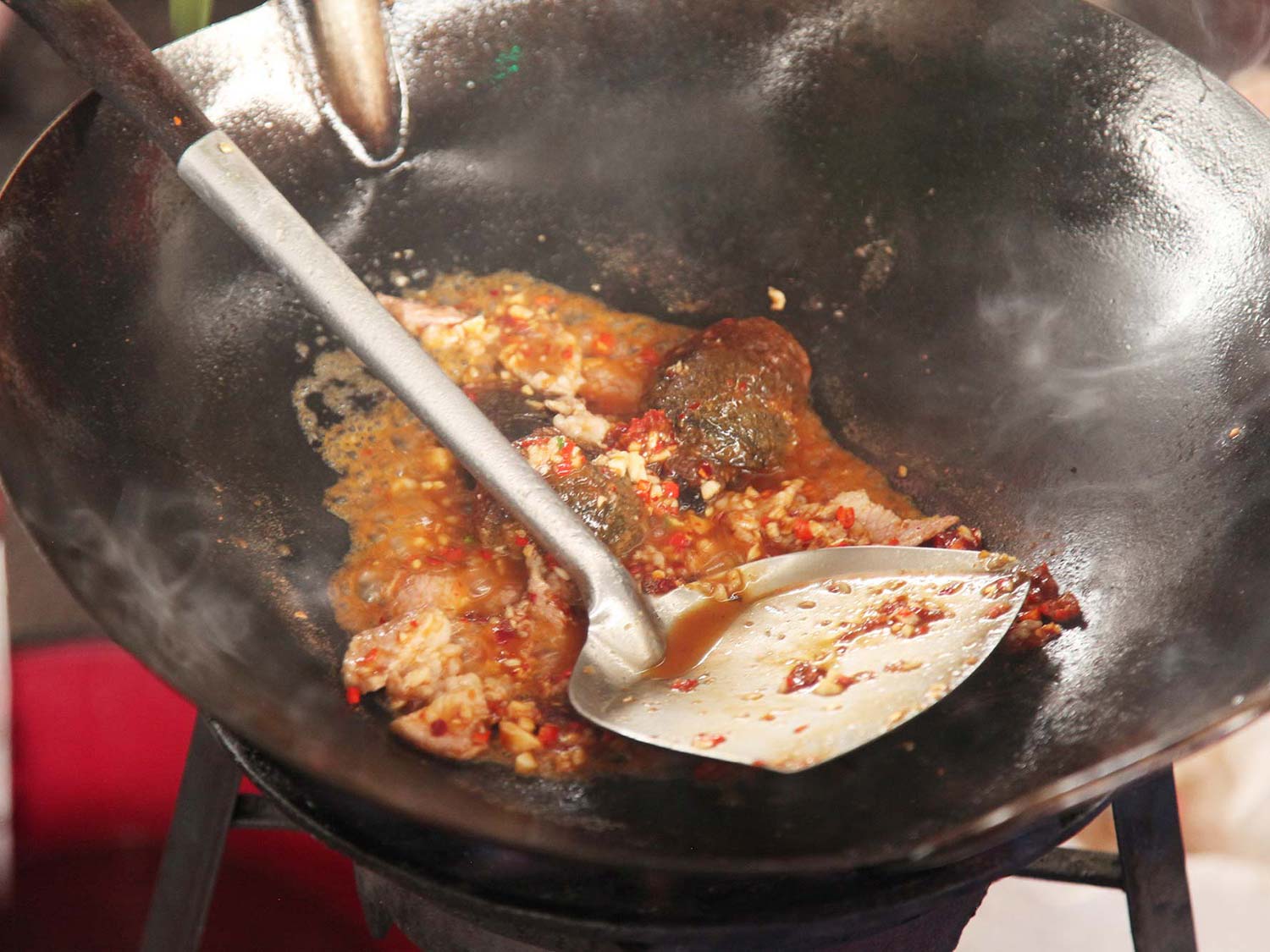
She cooks down the sauce until it's almost all evaporated, concentrating its flavor into a tight glaze. The dish gets transferred to a serving plate, then she turns back to the fryer.
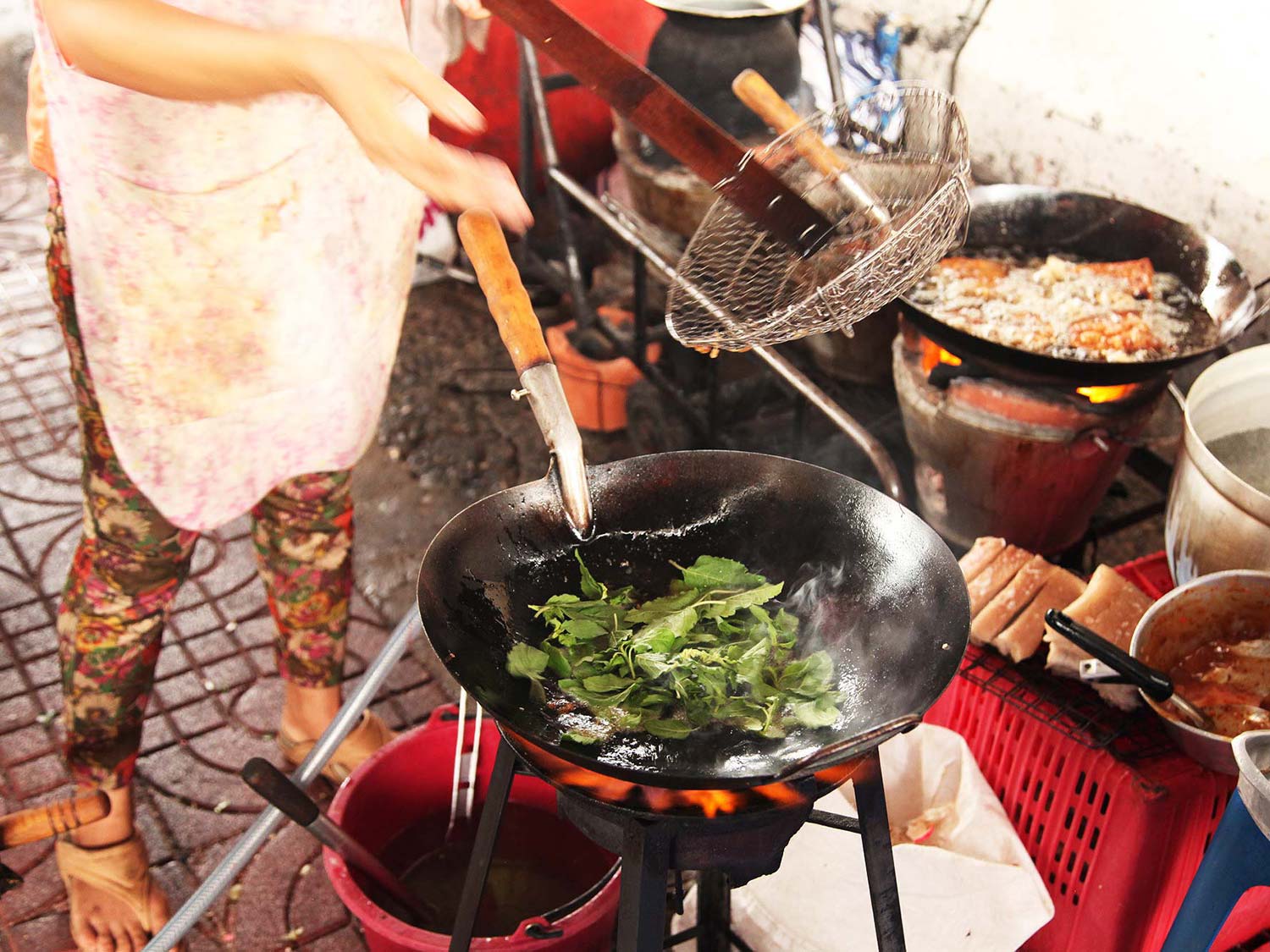
In goes a huge handful of holy basil, a Thai variety with a slightly more savory, almost minty quality to it compared to sweet Italian basil.
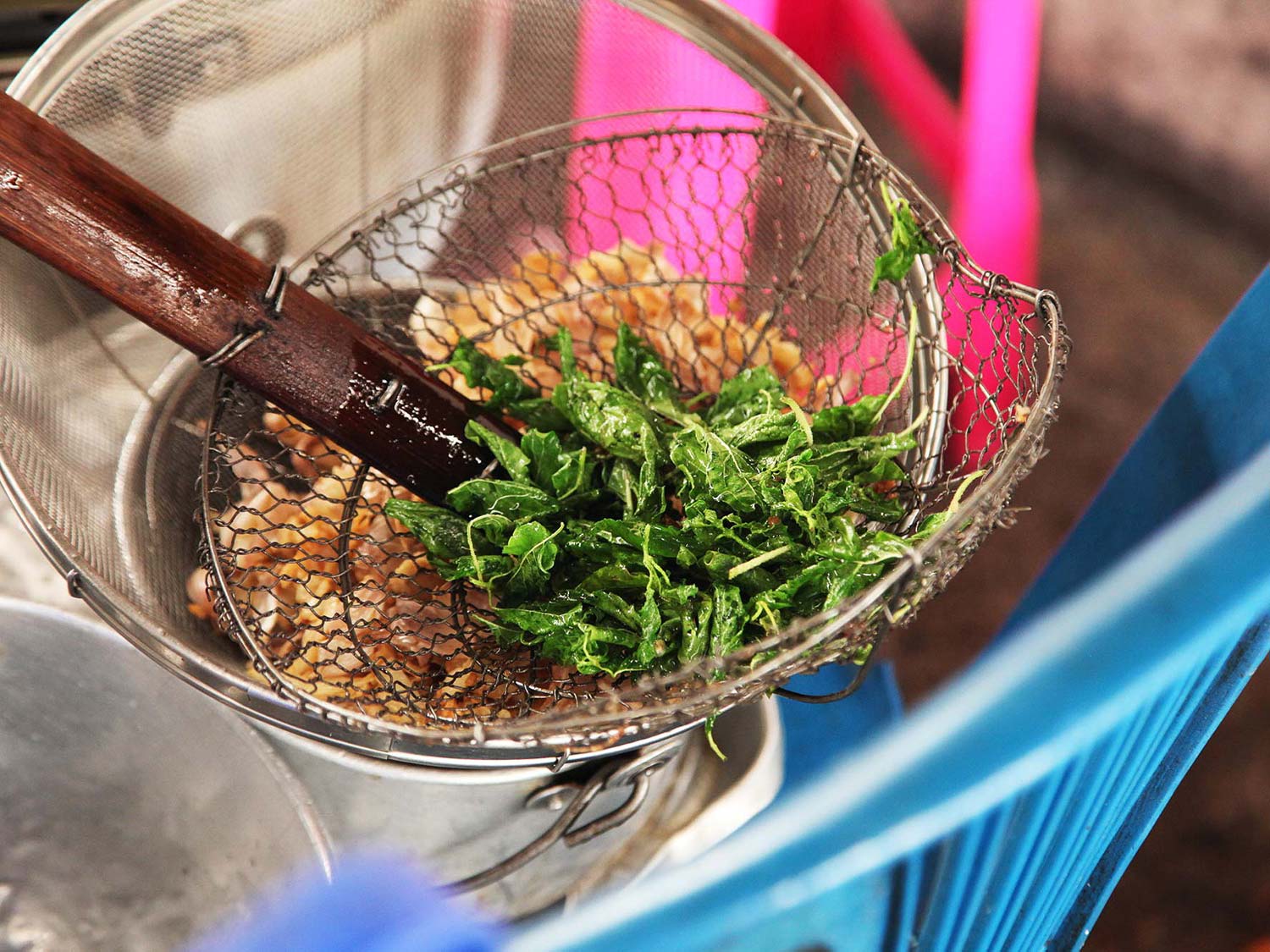
She fries it for just a few seconds until it crisps up, then drains it and dumps it on top of the stir-fry.
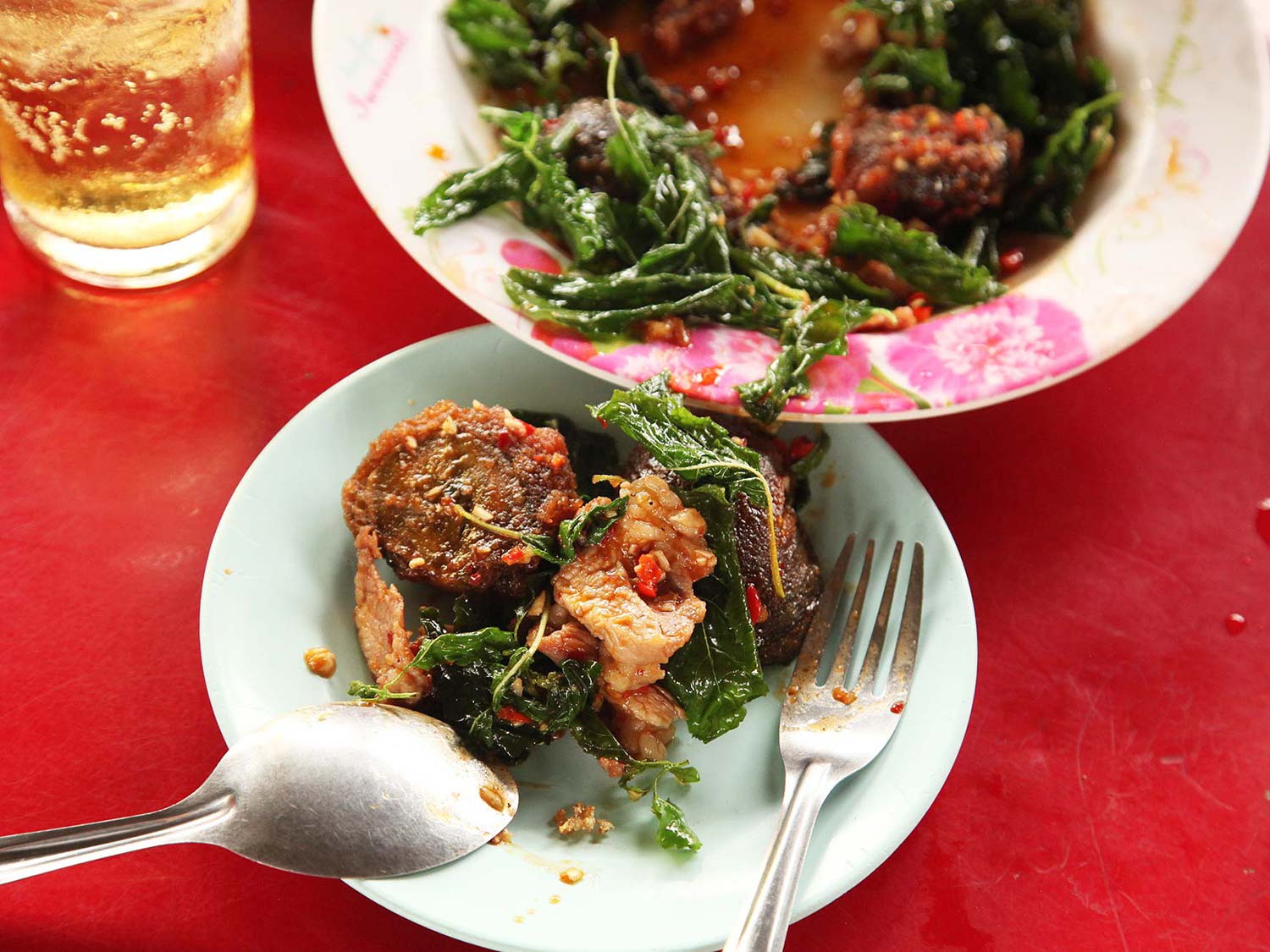
The finished dish is so damn simple, but offers an amazing array of textures and flavors. The egg with its crunchy fried exterior and creamy yolks, the tender slices of pork deeply flavored with fish sauce and chilies, the crisp curls of fried garlic. It epitomizes the thigns I love most about central Thai cuisine with its almost haphazard attitude towards technique that still manages to produce some seriously tasty end results.
I can't promise that this woman is here every day, but if you do visit Bangkok, I'd suggest swinging by her corner. Even if she's not there, you're destined to run across something delicious.